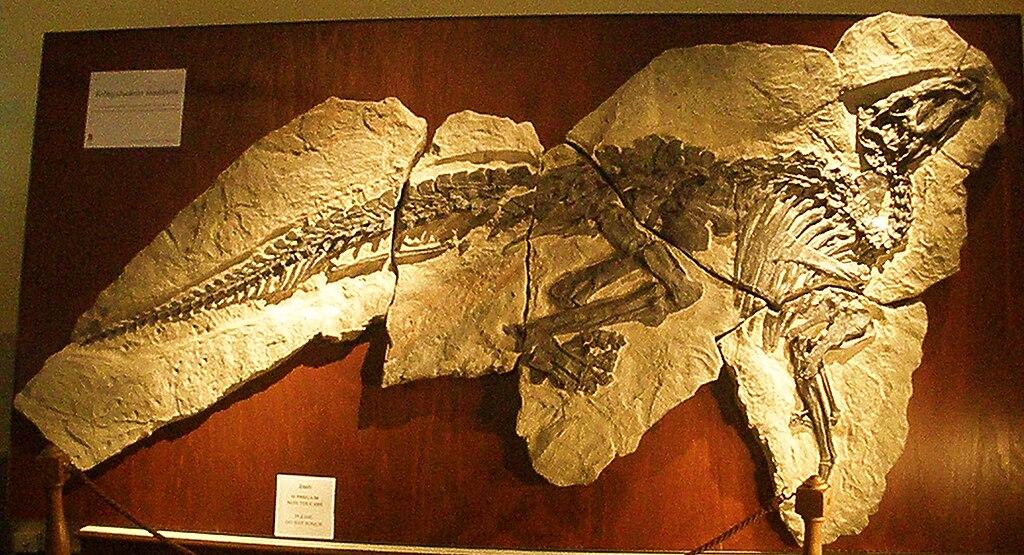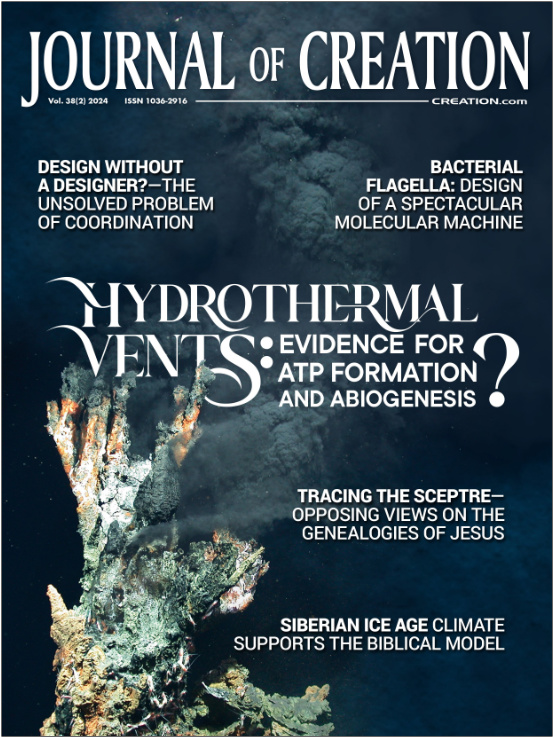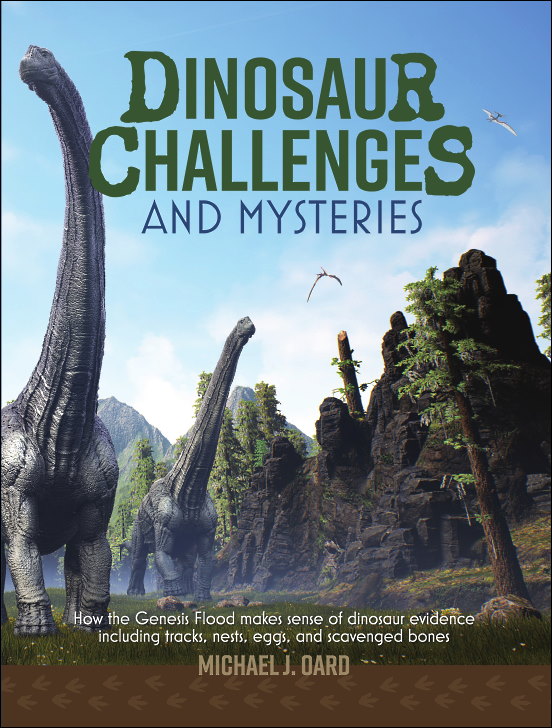Journal of Creation 38(2):11–13, August 2024
Browse our latest digital issue Subscribe
Unusual accumulation of dinosaurs in Italy better explained by Noah’s Flood
A herd of seven, and possibly up to eleven, dinosaurs has been discovered at a quarry in northeast Italy. The herd is believed to have been overwhelmed, buried, and fossilized together.1 At least seven skeletons are articulated, the bones being connected or nearly so. This is one of the few locations where nearly complete hadrosaur skeletons have been found outside of North America. The dinosaurs were assigned to an existing genus and species previously named in 2009, Tethyshadros insularis.
Original uniformitarian interpretations
The hadrosaur species was once thought to have lived 67 Ma ago on an island, when Europe was believed to be a series of islands in the northwest Tethys Sea.2 The species is believed to have come from Asia by island hopping. The date is based on foraminifera biostratigraphy, the stratigraphic framework of the karst plateau, and an alligatoroid fossil. The limestone is interpreted to be marine in origin.
The first individual of Tethyshadros insularis analyzed was considered fully grown with no juvenile features, but small for a hadrosaur, only 3.6 m long. Therefore, because it was believed to have lived on an island, researcher Dalla Vecchia thought it to be dwarfed. It is typical of the ‘island rule’ that large animals on islands become dwarfed, but small animals become larger.3

The dinosaurs were found in a lens of high-organic black limestone, 10 m thick and 70 m long. It was originally believed to have been deposited over a period of less than 10,000 years. Other organisms and organism products were fossilized at the same time as the dinosaurs and foraminifera: fish, small crocodilians, a flying reptile, several crustacean taxa, rare coprolites, pollen, and algae.4
Tethyshadros insularis has several peculiar features.2 It was said to have anatomical features adapted to a cursorial (running) lifestyle, and, although judged a ‘primitive’ hadrosaur, it had a mix of ‘primitive’ and ‘derived’ (advanced) features; in other words, it is a mosaic.
To uniformitarian scientists, such articulated skeletons buried together suggest herding of dinosaurs and gregarious behaviour. Parallel dinosaur trackways suggest the same. Such an interpretation is simply based on the idea that evidence for past behaviour should be assumed to have occurred under normal conditions of life.
New research suggests different uniformitarian interpretations
New research has turned much of their earlier interpretation on its head. First, the researchers redated the dinosaur fossils to 80.5–81.5 Ma, 14 million years earlier, based again on foraminifera biostratigraphy. The other methods of dating must have been flawed as well. This was enough for the new paleoenvironment to be a continent and not a series of islands in Europe.
Second, researchers discovered that at least one of the seven new hadrosaurs was of normal size, so the species was no longer considered dwarfed. Despite the earlier analysis, the first small hadrosaur found earlier2 was reinterpreted to be a young, immature dinosaur. Dalla Vecchia originally assumed the Tethyshadros specimen he described was an adult because some of the bones showed fusion. However, he did not cut open any bones to look at growth rings. Chiarenza et al.,1 however, did exactly that and realized that the smaller specimens were not full-grown. Dalla Vecchia did use methods appropriate for 2009 to analyze a dinosaur skeleton’s maturity. While he could have cut open the bones, that was impracticable for two reasons. First, it is a type specimen, which researchers prefer not to damage. Second, it was believed at the time that assessing skeletal fusion was a valid way to determine ontogenetic state in dinosaurs. Nonetheless, Della Vecchia was biased to think it was an island dwarf, since he assumed it was of Maastrichtian age (72.1 to 66 Ma ago) and that these were island environments. Therefore, he assumed insular dwarfism, in part because of his paleoenvironmental interpretation. This illustrates an important lesson: scientists must constantly keep in mind how much their paradigm shapes how they see the data.
Flood burial—a better interpretation
The data is better interpreted as the burial of dinosaurs in the Genesis Flood. These terrestrial animals were buried in a marine carbonate, which would be predicted by the Genesis Flood. The fact that the dinosaurs were pristinely buried together points to rapid burial, another prediction of the Flood.
These dinosaurs could have herded together because it was their normal behaviour, but it is also possible that this aggregation was due to the looming catastrophe,5 similar to elk in Montana that herd as winter approaches. It is also possible that they herded together on BEDS (Briefly Exposed Diluvian Sediment) during a temporary local drop in the Flood level,6 and then were buried when waves of sediment-filled water overwhelmed them.
Although the age of the 10 m of rhythmites is said to be a few thousand years, the researchers now believe it is an intermixture of several rhythmites and slumps.1 Rhythmites are normally interpreted as the result of slow deposition in periodically changing paleoenvironments. Many researchers now suggest that such rhythmites in the rock record are varves; i.e., each couplet deposited in a single year.7 But the fact that 10 m of finely laminated rhythmites had the same species of dinosaurs throughout would plausibly suggest such layering happened rapidly, possibly automatically by mass flow. This would be a good hypothesis for a creationist sedimentologist to test.
As for the mosaic nature of the species’ anatomical features, they can be explained in the Creation Model, where each kind has variable characteristics. Primitive and derived features are subjective evolutionary concepts. They arbitrarily assign age designations according to what they deem are primitive features or more evolved features. In this case the same hadrosaur had both primitive and advanced features. The Creation Orchard of Life expects variation within a Genesis kind (figure 1). Each kind has tremendous variability built in at the creation, and this variability can be expressed by different ‘species’, ‘genera’, and possibly ‘families’ depending on the boundaries of the kind. Indeed, previous creationist research has found evidence for multiple hadrosaur species belonging to the same kind.8 In this case, it is not unusual for a dinosaur to display both ‘primitive’ and ‘advanced’ features, or even cursorial (running) features, while other members of its kind do not.
References and notes
- Chiarenza, A.A., Fabbri, M., Consorti, L., Muscioni, M., Evans, D.C., Cantalapiedra, J.L., and Fanti, F., An Italian dinosaur Lagerstätte reveals the tempo and mode of hadrosauriform body size evolution, Scientific Reports 11(23295), 2021. Return to text.
- Dalla Vecchia, F.M., Tethyshadros insularis, a new hadrosauroid dinosaur (Ornithischia) from the Upper Cretaceous of Italy, J. Vertebrate Paleontology 29(4):1100–1116, 2009. Return to text.
- Baechens, S. and Van Damme, R., The island syndrome, Current Biology 30:R338–R339, 2020. Return to text.
- Anonymous, Fossils from a herd of 11 dinosaurs have been found in Italy, Newsround, bbc.co.uk, 3 Dec 2021. Return to text.
- Tuinstra, L., T. rex dinosaur relatives found buried together: were these Tyranosauridae social creatures? creation.com, 3 Aug 2021. Return to text.
- Oard, M.J., Dinosaur Challenges and Mysteries: How the Genesis Flood makes sense of dinosaur evidence—including tracks, nests, eggs, and scavenged bonebeds, Creation Book Publishers, Powder Springs, GA, 2011. Return to text.
- Oard, M.J., Ancient Ice Ages or Gigantic Submarine Landslides? Creation Research Society Books, Chino Valley, AZ, 1997. Return to text.
- Doran, N., McLain, M.A., Young, N., and Sanderson, A., The Dinosauria: baraminological and multivariate patterns, Proceedings of the International Conference on Creationism 8:404–457, 2018. Return to text.




Readers’ comments
Comments are automatically closed 14 days after publication.